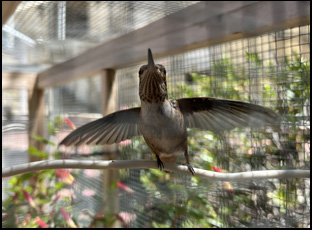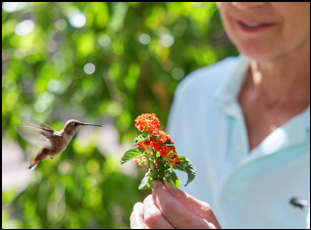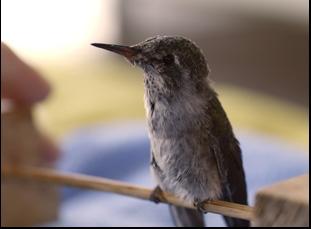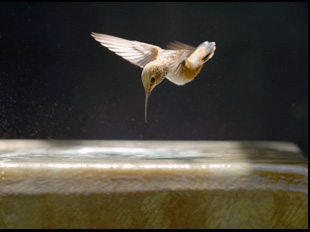“Do you think people are always honest with us when they bring in a bird?” Terry Masear says in “Every Little Thing,” a slightly jarring statement given what you may think Sally Aitken’s film will be about when entering the rehabilitation center that Masear has created above the metropolis of Los Angeles. Perched on the side of a hill in West Hollywood, her home may be akin to the ornaments that people place outdoors to attract hummingbirds to feed in relationship to the city, but on a much more massive scale as good samaritans known as “finders” are welcome to bring her the birds that have landed in their area after losing the ability to fly and their wings are in need of repair. While Masear clearly has to have an enormous heart to repair the wounded creatures, she doesn’t neatly fit the saintly role of caretaker that you might expect from a story about her benevolent practice, having a curt manner around other people and never entirely able to let her guard down.
Make no mistake that Aitken finds beauty of all kinds in Masear’s home, with the sight of hummingbirds marvelously fluttering in the air captured with high-speed Phantom cameras to sharply capture the power of their wigs to stay afloat without blurring, and the painstaking effort Masear puts into nursing all her tiny patients back to heath. But the director finds that all a bit more resplendent in light of the cruelty that everyone there has endured at some point in their life, gradually revealing that Masear’s dedication to helping the most vulnerable is likely tied to being in a precarious position in her youth where she could only find freedom from long-buried trauma after seeking independence from her family. A suspicion that one of the finders has brought her a bird that they’ve made worse by feeding with sugar water, a perhaps well-intended yet ill-advised replacement for the nectar they survive on, without disclosing that out of embarrassment, becomes indicative of the small and seemingly insignificant inflictions of pain that people put each other through on a regular basis that can ultimately create an uninhabitable environment.
Yet like the birds at its center that somehow find their way to lifting themselves up, “Every Little Thing” carries such weight gracefully, elegantly moving between Masear tending to new guests and revisiting ghosts from her past that continue pushing her towards the invaluable work she’s taken upon herself to do. Following her profile of the conservationist Valerie Taylor in “Playing with Sharks,” Aitken has shown a real affinity for telling complicated stories of women saving the world in quite literal ways and with “Every Little Thing” now starting its theatrical run after premiering this time a year ago at Sundance, she spoke about how the words leapt off the page of Masear’s book “Fastest Things on Wings” and into the realm of cinema for her, as well as creating a dynamic film from a single location and the skill they don’t teach you in film school to keep her crew’s spirits high during a production.

It’s a good question because initially I thought, “Well, is there enough here for a feature?” I was incredibly captivated by how quirky the idea was and the opportunity to film hummingbirds, but it wasn’t really until reading Terry’s book and then meeting Terry that I realized that there was such wisdom to be had in the most unexpected way. I thought, “Wow, that’s a really exciting invitation as a filmmaker. If you look for that opportunity and then can somehow put that into a cinematic story, that would be unusual.” So it was the perverse thing of it being a film that I’d never seen before, and certainly as the journey of the film went on from those initial meetings with Terry and reading her book, if you look at my dog-eared copy of it full of post-it notes, I started to think, there’s so much in this way that she sees the world and it seems so particular, it’s an invitation to these very big universal ideas of kindness and empathy and compassion that I thought were really interesting. The most peculiar film could have the widest offering philosophically and that was very engaging to me.
Only afterwards did I realize this really doesn’t leave her house or her perspective except to introduce the film. Was that difficult to abide by?
At the very beginning, I was convinced that we would be spending half of our time in Los Angeles and we would go back and we would follow [hummingbird] finders because how on earth would anybody make a film about a single character — one woman, one house and a bunch of birds? On paper, that does not sound that interesting. Yet that’s where the story is. That’s the potency. You are really in this place, trying to create this space and this way of engaging with the story, so [there was] the discipline of actually removing all of those original ideas and really focusing on the purity of that. And I remember Tania Nehme, a beautiful editor who cuts drama as well as documentary, saying, “What do you think this story is?” And I said, “I don’t know what this story is, but I do know that whatever we do, we have to make the smallest things feel absolutely gigantic. That’s the only rule.” And she [said], “Okay, we can work with that.”

It was so hard. That’s what I imagined it was, but [I thought with] the weight of these hummingbirds, how am I going to make it cohere? [The past] was heavy. And this is such a nerdy thing, but I use a software program called Scrivener for writing documentary scripts and at one stage, I had three scripts going across two monitors. I had Terry’s biography, I had the bird characters, and then I had the finders, and I [thought], how do I plan this? And I had this one day where I realized if I made this master script, I could actually drag scenes from each of the three into the master script and I wouldn’t lose them out of the original and it was like the choir sang. I [thought] I have technically worked out how I can write the script.
The whole journey of the edit was interesting because some of the ideas were consistent from before even shooting of having this very lyrical experience. I knew that there was an amazing opportunity in the cinematography, particularly the wildlife cinematography, but I didn’t know how I was going to represent Terry’s personal story. And I became very interested in the idea of the thematic idea of trauma and resilience and healing, but like memory, those experiences are still within us. They never really leave, so I became very interested in the idea of fractured memory and not being literal about anything because that’s actually not how the brain works. It’s not how we move through life. You’ll see something and it will remind us of something from our childhood, so that’s where the use of archival film [came in].
There was a funny moment when Tania said, “I think I need more archive,” and I said, “Okay, great, no problem.” But that’s like the widest brief of all time, so we played around with a number of image ideas, but we obviously leaned into the opportunity to showcase the cinematography of the birds. And then there was a natural extension to think about flowers being very symbolic of growth and renewal and there’s other delicate imagery of spiders’ webs and dew drops, [as well as] this archival film texture, which gives a feeling more than a image.

Very early on, I knew that there was an opportunity for aerials and macro photography because I wanted to be as close to the hummingbirds as possible. They’re tiny, so you need to be really close and we wanted to also be able to slow this [footage down] because the birds move, depending on the species, 50 beats a second or more, depending on the species. So we had the Phantom photography, but it’s like anything, you can’t actually have a film full of that footage either, so it’s the combination of those elements of the observational filming, which is beautifully shot, but observational filming — the way that the human eye sees life — and then the archival, ephemeral, textured stuff, and then the high speed. You used the word “fluid,” which I appreciate so much [because] it was this movement between all of those elements that I think gives you the journey. I think a lot of people remember the wildlife cinematography because it is so spectacular, but I do know in my bones, it is, if not more spectacular because of the way all of the other elements support it in the film.
Getting to know Terry as you did must’ve been an interesting experience all on its own when you came to know her through the book, then at a distance over Zoom and then suddenly in her house, seeing her in her element. What was it like discovering her as a person?
First of all, it’s like a baptism of fire. It’s an incredibly intense experience filming observationally at the best of times, and then throw into that the fact that for Terry, these lives are on the line and woe betide you if you get in the way of that. So it’s this very supercharged atmosphere, yet you’d [think], “How stressful can those birds be? They’re so small.” It was so stressful. It was like being in a field medic situation. But there’s some kind of alchemy that happens when you are in these experiences of filming very intensely and longitudinally and I didn’t know anything about Terry’s personal story when we [started]. I knew that Frank had been in her life, but that was about it, and it was during filming the interview that she started to tell me about her childhood and a lot of things made sense to me then. It was like it almost revealed itself to her as much as it revealed it to me.
After the fact, when you share something of yourself, particularly on camera, you’re very vulnerable and she said, “Oh, I don’t know, that’s not very relevant, is it? Isn’t it about the birds?” And I said, “I think it might be quite relevant, and of course, it’s about the birds, but it’s as much about you as it is the birds.” And then she said, “You’re so right,” so it was this very evolving journey of finding the story. And what a privilege because we live in a world of algorithms, but the algorithm would not have made this film.

For those that know me, I bake a lot. I like to create. And cooking is as much of a creative act as filmmaking. I think I made pancakes and cakes and other bits and bobs, and it’s a meditative thing in some ways and there’s something about it that’s communal as well. As long as they didn’t get bored of the baking or sick, it’s a success as far as I’m concerned. And there were definitely requests for seconds.
“Every Little Thing” opens on January 10th in New York at the IFC Center before expanding on January 17th to Los Angeles at the Monica Film Center and Laemmle Glendale, Columbus at the Gateway Film Center, Hudson, New York at Time & Space Limited, Scottsdale at the Harkins Theater Shea 14, Modesto at the State Theater and Cary, North Carolina at the Cary Theater. A full list of theaters and dates is here.



